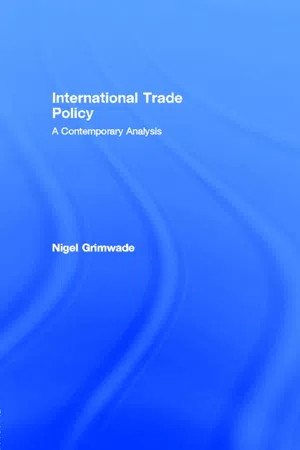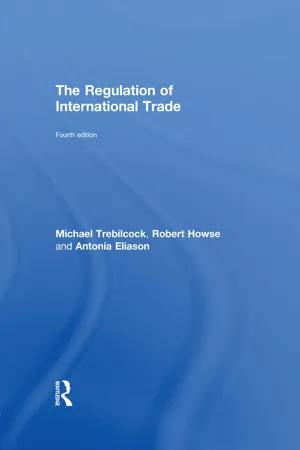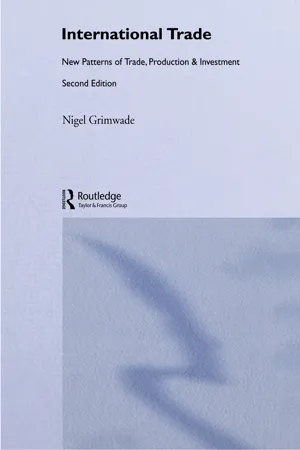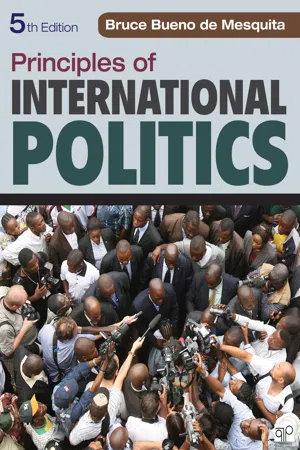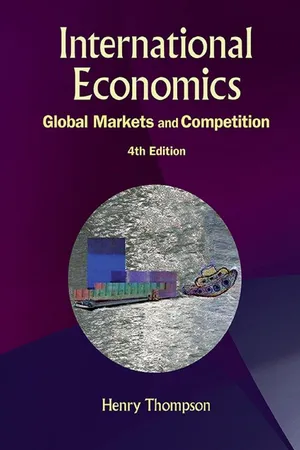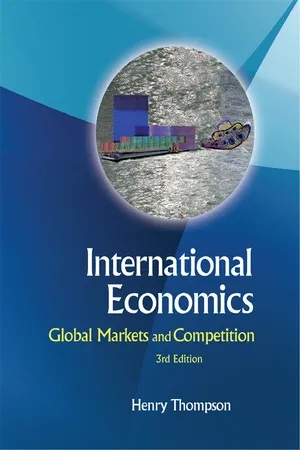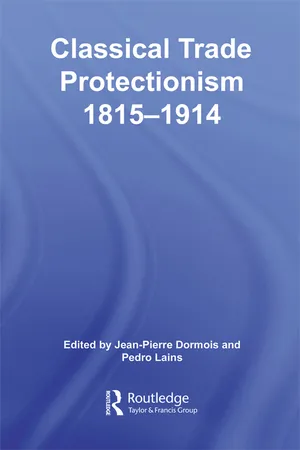Economics
Benefits of Tariffs
Tariffs can protect domestic industries from foreign competition by making imported goods more expensive. This can help preserve jobs and prevent the loss of domestic industries. Additionally, tariffs can generate revenue for the government, which can be used for various public services and infrastructure projects.
Written by Perlego with AI-assistance
Related key terms
10 Key excerpts on "Benefits of Tariffs"
- eBook - ePub
International Trade Policy
A Contemporary Analysis
- Nigel Grimwade(Author)
- 2006(Publication Date)
- Routledge(Publisher)
If tariffs impose costs on countries, why do countries impose tariffs? There are several possible explanations. Firstly, governments often act irrationally because they are ill informed. In brief, they act in ignorance of the damage which tariffs are inflicting on the country. Mistakenly, they believe tariffs to be beneficial to the economy as a whole. Although not an implausible explanation, it lacks credibility. Governments employ advisers, who include professionally trained economists. It would seem improbable that governments could remain ignorant of the costs of tariff protection for very long. Some other motive must therefore exist. One possibility is the existence of some other noneconomic benefit which is considered sufficiently important to justify the economic cost. Governments pursue many objectives which are not part of the economists’ calculus. This is undoubtedly a reason for many of the tariffs which governments impose. An example is the tariff protection given to an industry deemed to be of vital strategic importance to the country (such as a tariff on imported steel products). Another example is tariff protection granted so as to raise the relative incomes of a particular sector or social group (such as farmers) thought to be at special disadvantage. Economists cannot comment on whether governments should or should not pursue such objectives. However, they can point to the costs of doing so and insist that these be set against any expected benefit. Moreover, they can ask whether a tariff is the best way of achieving the objectives being sought. There might be other policy instruments (for example, a subsidy) which could achieve the intended objective more efficiently or at less cost.Yet a third reason for tariffs is the possibility that they bring some economic gain which more than offsets the static welfare loss measured by the conventional model. Attention has already been drawn to the optimum tariff argument although it was argued that this has rather limited practical application.There are at least two other situations in which a tariff might conceivably be beneficial. In the first, the market for a product is imperfectly competitive such that firms are able to earn supernormal profits in the long run. A tariff might then be used to ‘shift’ profits from foreign firms to domestic firms and therefore from the exporting to the importing country (see Brander and Spencer, 1981, 1984; Krugman, 1986). Such profit-shifting or ‘rent-snatching’ tariffs may enable the tariff-imposing country to raise its economic welfare at the expense of others. This is similar to the optimum tariff argument set out above. Like the optimum tariff, the argument holds only under certain fairly restrictive assumptions (see Grossman, 1986). Its application is confined to so-called ‘strategic’ industries dominated by a few sellers and in which entry barriers limit the potential for new firms to enter the industry and compete away excess long-run profits. There is the further problem of selecting or ‘targeting’ the right industries to protect. High long-run profits may be a return for greater risk rather than an indication that competition is absent. Moreover, in most cases a tariff is inferior to a subsidy as a method for supporting such an industry. This is because a subsidy does not raise the price of the imported good and therefore inflicts no consumption loss on the importing country. Finally, as with the optimum tariff, there is a danger that a profit-shifting tariff will provoke foreign retaliation, leaving both countries worse off. - eBook - ePub
The Regulation of International Trade
4th Edition
- Robert Howse, Antonia Eliason(Authors)
- 2013(Publication Date)
- Routledge(Publisher)
7 Border measures
Tariffs and quantitative restrictions
TARIFFS OVERVIEW
Tariffs are essentially taxes on imported goods, and they, as well as other customs duties, must be applied in accordance with the Most Favoured Nation (MFN) principle discussed in Chapter 2 of this book. Additionally, WTO Members may, but are not obligated to, commit to binding certain customs duties that may generally be understood as committing to maximum duties for particular products.1 Binding is in accordance with the object and purpose of both the WTO Agreement and the GATT 1994. These two Agreements in their respective preambles recognize the desirability of ‘reciprocal and mutually advantageous arrangements directed to the substantial reduction of tariffs and other barriers to trade’. Members’ commitments vary, are usually the product of multilateral trade negotiations, and are included in schedules of concessions which may be found in the annexes of the GATT.THE ECONOMIC EFFECTS OF A TARIFF
The economic effects of a tariff on both importing and exporting countries are best understood by first examining the case of a prohibitive tariff, a tariff that is so high that it prevents all imports. Here we draw on an example provided by Ruffin and Gregory.2 (See Figure 7.1 .)With a prohibitive tariff, the prices paid for shirts in each country are determined by the supply and demand curves in each country. To compare prices, we assume that US$2 = £1. If there was no tariff, prices would be the same in the two countries. The prohibitive tariff in America raises the price in America from US$6 to US$9. Consumers lose area A + B, but producers gain area A. The net loss to America is area B. In the UK, prices fall from £3 to £2, and producers lose area C + D, while consumers gain C. The gain to consumers is less than the loss of producers. The net loss to Europe is area D.One can next consider a non-prohibitive tariff, which does not preclude all imports of a product. Ruffin and Gregory graph this example as in Figure 7.2 . Before the nonprohibitive tariff, the price of the product is Pw . The tariff raises the price to Pw + T which is the world price plus the amount of the duty. Consumers lose area N + R + T + V. Producers gain N. The government gains the tariff revenue T, which equals the tariff per unit times the quantity of imports. The net loss is R + V. The tariff lowers imports from (q4 – q1 ) to (q3 – q2 - eBook - ePub
- W. Charles Sawyer, Richard L. Sprinkle(Authors)
- 2020(Publication Date)
- Routledge(Publisher)
On the import side of the market, the gains are diffused among thousands or even millions of consumers. The fact that greater imports are saving consumers (through lower prices) money on their purchases of cloth often goes unrecognized. The large gains to consumers in total come from relatively small gains over a very large number of purchases. The gains from trade are large in total, but the gains for any particular item frequently are small. Although the gains are diffused among consumers, the losses to producers and workers are concentrated. For example, firms in an industry that competes with imports face lower or even negative profits or in the extreme case, bankruptcy. Workers in such an industry may see wage increases that are lower because of competition from imports. If the import competition is large enough, the workers may experience reduced hours or even loss of employment. Given these losses, it is asking a lot for the industry to calmly accept this as the price paid for the greater economic good.THE ECONOMIC EFFECTS OF TARIFFSTo analyze a tariff’s economic impact, we need to separate the effects that a tariff has on consumers from the effects it has on domestic producers. To separate these effects, we can use the concepts of producer and consumer surplus developed above. The central point of the analysis is that there is a net loss to a country’s welfare that results from putting a tariff on imported goods.The effects of a tariff for a small countryNow, let us use the concepts of consumer and producer surplus that we just developed to analyze the impact of a tariff. We begin our analysis by considering the case of a country whose imports constitute a very small portion of total world imports. The importing country is referred to as a price taker because it is so small that it cannot influence world market conditions. In Figure 8.4 the domestic demand and supply of cloth is illustrated. Before international trade, equilibrium in the domestic cloth market occurs at point E. The equilibrium price and quantity of cloth associated with this point are P and Q, respectively.FIGURE 8.4Domestic effects of a tariffThe tariff placed on imported cloth raises the price of cloth from Pw to Pt. As a result of the price increase, consumer surplus declines and producer surplus expands. The country’s welfare falls by the amount equal to the production effect—triangle b—and the consumption effect—triangle d. - eBook - ePub
International Trade
New Patterns of Trade, Production and Investment
- Nigel Grimwade(Author)
- 2020(Publication Date)
- Routledge(Publisher)
Despite the fact that free trade increases global economic welfare, most governments interfere in trade. Usually, the main reason for doing so is to grant protection to a particular industry threatened by foreign competition. Protection may take the form of imposing tariffs on imports or the creation of various kinds of non-tariff barriers. Trade may also be distorted by government measures that favour domestic producers over foreign producers (e.g. granting a subsidy to a domestic producer). In the next two sections of this chapter, the effects of these kinds of government interference in trade are examined. We begin with tariffs because they are perhaps the most obvious form of government-imposed barrier to trade.Tariffs may take the form of a specific duty payable on each unit imported or an ad valorem tariff expressed as a percentage of the unitBox 8.1 The Effects of Increased Trade: Inter- and Intra-Industry Specialisation ComparedThe Effects of Inter-Industry Specialisation
- Static effects - lower prices and improved resource allocation
- Dynamic effects
- Economies of large plant size
- Increased price competition
- Increased capital investment
- Increased rate of technological change
- Higher output due to higher real incomes
- Industry trade balances widen - may lead to resistance to lowering trade barriers in import-competing sectors
- Adjustment costs Need for inter-sectoral re-allocation of factors Need for relative factor prices to change (where factor intensities differ between export and import-competing sectors)
- Distributional effects - price of country's scarce factor may fall relative to price of country's abundant factor
The Effects of Intra-Industry Specialisation
- Static Effects
- More varieties of each type of good become available (love for variety)
- Consumers able to get a variety closer to their preferred type
- Some reduction in prices due to increased competition
- Dynamic Effects
- Scale economies due to more plant specialisation (long production runs)
- Learning by doing effects (dynamic scale economies)
- eBook - ePub
- Bruce Bueno de Mesquita(Author)
- 2013(Publication Date)
- CQ Press(Publisher)
Tariffs, or fair trade, as such policies are sometimes labeled, are classic private goods subject to many of the political considerations discussed in the context of the selectorate theory. Unregulated trade is a public good that is likewise subject to the political considerations addressed in that same theory. It should be evident that free trade benefits many, whereas fair trade benefits only a few. For the few, of course, the benefit from tariffs may outweigh the value of the public benefit that everyone gets from free trade. Presumably, if no one benefited more from trade protection than from free trade (i.e., if the public-goods benefit outweighed the private-goods component for everyone), then there would be no tariffs or other means of making imports less competitive. In this regard, we should note that tariffs arise for more than one reason. Tariffs can be used to protect domestic industries from competition, as is commonly the case, but they can also be used to punish foreign governments that do not observe free-trade policies in their own right. President George W. Bush justified his call for a tariff on certain steel products in March 2002 by alleging unfair trade practices by Japan and Europe designed to bolster their steel industries at the expense of American industry. They countered—apparently correctly, given how readily the Bush administration negotiated a resolution favorable to Europe’s and Japan’s steel industries—by threatening retaliatory tariffs to compel the United States to enforce its free-trade obligations under the WTO.In all these cases, domestic political considerations seem to be behind the use of tariffs as foreign policy maneuvers. That still leaves us with questions about how tariffs and other trade policies are used by political elites to pick and choose winners and, in doing so, pick and choose how to reward their winning coalition or harm their adversary’s coalition.TRADE AND DOMESTIC WINNERS AND LOSERS
We have seen that free trade, on average, provides cheaper goods and services to consumers. It also provides more abundant goods and services both in quantity and in diversity. Yet free trade has not been the norm throughout history. I have already hinted at why this is so. Free trade is a public good, but the effects of trade involve both public- and private-goods components. Trade affects domestic producers and sellers differently from importers, exporters, and consumers, and government trade policies affect the wealth of each of these groups differently. So the distribution of wealth in a society depends, in part, on governmental approaches to trade. If trade is unrestricted, then domestic producers for the domestic market are at a potential disadvantage, and foreign exporters and domestic importers could have an advantage. Each, depending on how well tied in they are to the leadership’s winning coalition, will lobby more or less effectively for their private, coalition-based gains at the expense of those not in the coalition. In the US setting, for instance, that means that labor union interests will more effectively distort trade policies to protect labor when the Democrats are in office. Large US corporate interests, as reflected by the Chamber of Commerce, the National Association of Manufacturers, and individual corporate lobbyists, will more successfully distort trade policies to protect their interests when the Republicans are in office. In smaller-coalition regimes, the private goods component of trade protection will loom considerably larger than in a large-coalition setting such as in the United States. - eBook - ePub
International Economics
Global Markets and Competition
- Henry Thompson(Author)
- 2017(Publication Date)
- WSPC(Publisher)
The economic calculation and rational policy required to apply optimal tariffs do not exist. The political process of protection is anything but scientific. Industries have the incentive to lobby for protection. Tariffs benefit the protected industry that pays politicians protectionist laws.Small countries have less incentive to impose tariffs. LDCs are exempt from WTO rules and are allowed to set their own tariffs. LDCs are typically small and their optimal tariff is zero.EXAMPLE 4.7 US Energy ImportsThese figures show US consumption and imports of energy during the late 21st century. US energy sources are coal 40%, natural gas 27%, oil 18%, and hydro/nuclear 14%. Due to international environmental agreements, coal will decline and natural gas rise over the coming decades. Alternative backstop energy sources will eventually become economical as the price of nonrenewable fuels rise. Nuclear power is a backstop but with political and waste disposal problems.Section B Problems
B1. Illustrate foreign gains from a tariff on services in a production frontier diagram similar to Figure 4.8 .B2. Illustrate how a tariff war could eliminate trade.B3. What is the analogy between the optimal tariff and the optimal price for a monopoly?C. TARIFF GAMES
Players in game theory have conflicting goals and make choices based on strategy. The outcome depends on strategies. Board games, cards, and sports are strategic games. This section looks at tariffs as a game between large open economies.Tariffs in the Prisoner’s Dilemma
Consider two countries that trade in a two party game. The two countries can gain with a tariff through improved terms of trade but only at the other’s expense. If one’s gains are exactly offset by the other’s losses, the game is a zero sum game. Tariffs are a negative sum game since total losses outweigh gains. Suppose each country decides whether to impose a tariff that lasts one year. The choices are free trade or a 10% tariff. Choices are announced simultaneously.With free trade income is 100 in each country in the payoff matrix Table 4.1 - eBook - ePub
Free Trade under Fire
Fifth Edition
- Douglas A. Irwin(Author)
- 2020(Publication Date)
- Princeton University Press(Publisher)
These anti-import policies reduce trade and tend to distort economic activity, leading to inefficient outcomes (in the absence of offsetting effects). Economists tend to focus on two effects of tariffs and other policies. First, import barriers redistribute income from domestic consumers to domestic producers. When imports of a product are restricted, the product becomes scarcer in the domestic market. Scarcity drives up the price, benefiting domestic producers of the product but harming consumers who are forced to pay more for it.Second, protectionist policies distort domestic prices in a way that leads to inefficiency (wasted resources), or in economic jargon, a deadweight loss. As import restrictions push the domestic price of a good above the world price, domestic firms produce more (at a higher cost than the goods would be available on the world market), while consumers buy less than they otherwise would, forgoing some of the benefits of consumption. The inefficiency associated with these distortions of incentives imposes a deadweight loss on the overall economy. Trade barriers are like an income transfer in which ten dollars is taken from consumers while giving only eight dollars to producers, resulting in a two-dollar loss to the economy as a whole.In 2018, President Trump, who calls himself “Tariff Man,” unleashed successive waves of tariffs. The first wave saw the imposition of 30 percent duties on imported solar panels and 20 to 50 percent on imported washing machines. The second wave included a 25 percent tariff on steel imports and a 10 percent tariff on aluminum imports. The third wave targeted imports from China, 25 percent tariffs on $34 billion of imports in July, 25 percent tariffs on an addition $16 billion in imports in August, and 10 percent tariffs on another $200 billion in imports in September. (This was followed by plans, in December 2019, by another $300 billion in imports from China being taxed at 10 percent, unless a truce was reached.)One study of these tariffs confirmed that the demand for imports is downward sloping in that higher tariffs reduce imports: A 1 percentage point increase in the tariff rate gives rise to a 6 percentage point fall in imported quantity. The researchers also found that the tariffs were fully passed through to domestic consumers of those goods. (There was some question whether foreign exporters would absorb some of the tax in the prices they charge in the U.S. market.) The total cost to consumers was $52.8 billion, or $414 per household, some of which was transferred to domestic producers. Payments to the government in tariff revenue was $36 billion. Taking the consumer cost and subtracting transfers to producers and the government, the cumulative deadweight loss through November 2018 was $6.9 billion. If the tariffs remain in place, the costs for 2019 and future years would be higher than this because the tariffs were phased in over 2018.10 - eBook - ePub
International Economics
Global Markets and Competition
- Henry Thompson(Author)
- 2011(Publication Date)
- WSPC(Publisher)
CONCLUSIONShrimp has become a leading seafood in the US due to low cost farming techniques and global competition but hold the hot sauce. US shrimpers won a dumping case with the ITC in 2004 and were awarded tariffs of 100% on imported shrimp. There was no evidence of predatory pricing or selling below cost by exporting Asian countries. The money to pay for the ITC filing came from disaster relief for shrimpers. Congress also awarded the shrimping industry the tariff revenue in direct violation of WTO rules. The US exports soybeans to Asia for shrimp food and soybean farmers lobby to repeal the shrimp tariffs. The only sure winners are lawyers and economists, and government officials receiving lobby payoffs.Protectionism is the oldest issue in economics and a vital contemporary issue. Protectionism will continue as long as the benefits to protected industries outweigh the costs of lobbying. In a large economy, protection may affect international prices and Japan, the EU, and the US are large economies in imports of oil, automobiles, and consumer goods. The next chapter shows how the terms of trade are determined between large economies, and how a tariff may improve the terms of trade.
MAIN POINTS • Tariffs impose deadweight losses that benefit the protected industry at the expense of the economy. • Quotas and other NTBs have become popular due to lower tariffs in the WTO. • Protection shifts production away from industries with a comparative advantage, creating efficiency losses.Terms Antiprotection Production distortion Deadweight loss Protection Dumping Quality upgrading Effective protection Quota license Fair trade Quotas ITC Rent seeking Logrolling Tariffs Nontariff barrier (NTB) Voluntary export restraint (VER) • Protectionism occurs when benefits to the protected industry outweigh cost of lobbying. Consumers would benefit from free trade. Antiprotection is lobbying for free trade by industries that export or buy imported intermediate products.REVIEW PROBLEMS1. Problems 1 through 9 are based on the do-mestic demand for sports shoes D = 100 – P and domestic supply of S - eBook - ePub
- Jean-Pierre Dormois, Pedro Lains(Authors)
- 2006(Publication Date)
- Routledge(Publisher)
6 Mexico also imposed high tariffs and brought about “substantial import substitution, particularly in textiles, clothing, processed foods and beverages, tobacco, cement, and other building materials” (Reynolds, 1985: 100). Whether restrictive trade policies were responsible for the strong growth is still open to question. Thus, the relationship between trade policy and economic performance is a complicated issue that cannot be inferred from a simple correlation alone. As Cynthia Taft Morris and Irma Adelman (1989: 1420) concludesuccess along this inward-oriented growth path varied greatly [in the late nineteenth century] . . . in moderately backward, import-substituting countries protection levels varied greatly and did not systematically accelerate economic growth. . . . In sum, the effects of tariff policies are complex and vary greatly across countries in ways depending strongly on resources, institutions, and government strategies.What explains the high tariffs?
Why did export-oriented countries such as Argentina levy high tariffs if they did not employ them as part of an import-substitution trade strategy? In many cases, import duties were primarily designed to raise fiscal revenue for the government. Figure 8.3 illustrates that labor-scarce, land-abundant countries often relied on customs duties to generate a large propo rtion of their government revenue. Figure 8.4 shows that these countries also tended to impose high tariffs.Land-abundant countries tended to impose high tariffs for public finance and for political economy reasons. In terms of public finance, import taxes made sense for countries with low population densities. Other means of raising revenue (excise taxes, land taxes, income taxes, etc.) were not as feasible or as enforceable in countries with a widely dispersed population, particularly in the late nineteenth century. The taxation of foreign goods arriving at the nation’s ports reduced the problem of tax compliance. In terms of political economy, if a majority of the population owns land (or if the government is controlled by landowners), they may have an interest in avoiding direct taxes on land in favor of high taxes on imported luxury goods.7 - eBook - ePub
Tariff Determination in the General Equilibrium of a Political Economy
A Bargain-theoretic Approach to Policy Modelling
- Hom Moorti Pant(Author)
- 2019(Publication Date)
- Routledge(Publisher)
10 Second, the nature and the form of the objective function of the government have not been specified. Third, the lobbying cost-of-tariff function for the injured factor has an ad hoc character. It has not been explained why the cost rises tremendously as the tariff rate approaches to offset the terms of trade change. Fourth, as Baldwin argued in his comments on Feenstra and Bhagwati’s paper, it is not clear why the gaining factor does not spend resources in counter lobbying to maintain its gains when the terms of trade change and the injured factor lobbies for an increased tariff protection. Fifth, it is not clear at all whether the hypothesized behaviour of the government has a normative or a positive content. In summary, the approach suggested by Feenstra and Bhagwati, though interesting, does not seem very useful for modelling the process of tariff formation.2.4 Forms of protectionThe studies reviewed so far have assumed that tariff policy is the only instrument available to the government to pursue its objective, whatever it may be. With this assumption these studies have established that the government will change the tariff rate especially when international terms of trade change. Strictly speaking, these studies have shown that it would be in the interest of the government, for political or welfare reason, to insulate the domestic economy from foreign price shocks. They have not determined whether commercial policy interventions will be in the form of a tariff rate, quota, subsidies or something else.There are situations in which the protective instruments are not equivalent. For example, Warr and Parmenter (1986) have shown that, in a situation with labour market disequilibrium, protection awarded through government procurement policies may dominate tariffs in terms of maintaining employment elsewhere in the economy.
Learn about this page
Index pages curate the most relevant extracts from our library of academic textbooks. They’ve been created using an in-house natural language model (NLM), each adding context and meaning to key research topics.
